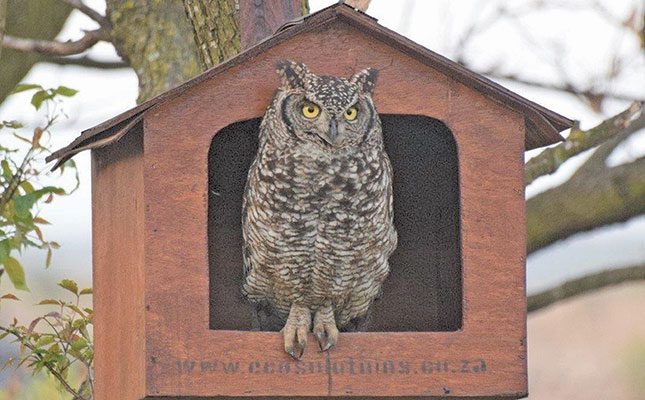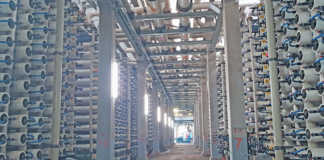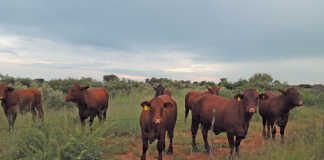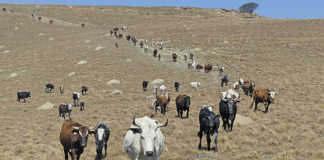
Photo: Supplied
Owls and bats are specialised hunters. Research has consistently shown that they can make a big impact on reducing pest numbers on farms.
A pair of barn owls and their chicks feed on 2 000 to 6 000 rodents a year, according to research conducted by the Ministry of Agriculture in Israel.
Israel initiated a project to monitor the efficacy of barn owls for rodent control in crops in 1983 already, and following the success, increased owl boxes across the country to nearly 4 000 boxes today.
Many grain farmers there have shifted to using barn owls, and have reduced the use of pesticides or refrained from using them altogether, without an evident impact on yield.
A research project looking at the impact of bats on insect damage caused to macadamia nuts in Levubu, Limpopo, found that damage caused by macadamia-nut borer and false codling moth could be reduced by 35% if sufficient numbers of bats and owls were present in the orchards. Removing the winged creatures from the orchards, on the other hand, resulted in a 60% reduction in yield.
Jordan-Michael Hardey, the communications manager at EcoSolutions, refers to bats as the ‘bug police’.
“They fly around, catching insects using a process called echolocation to find their insect meals. They make high-pitched sounds that bounce off objects and return to the bat as echoes. Bats in flight can distinguish the difference in sound between a tree, your head and an insect, which is how they locate their food in the dark.”
About 70% of all bats eat insects, with each eating half their weight in insects a night. Bats are also responsible for pollinating fruit like avocados, bananas, dates, figs, mangoes and peaches, and they spread seeds.
The density of populations of both bats and owls is a big determining factor in how effective these animals will be for pest control. Hardey, however, notes that since barn owls are able to regulate their numbers based on the available prey, farmers need not worry about owls vacating an area after clearing out all the rodents.
“The size of a territory held and defended by an owl pair is governed by the prey availability required by that pair. In years where rodent numbers are high, territories will be smaller, while the converse is true when rodent numbers diminish.”
However, owls are one of the few predatory species that have the ability to dramatically regulate their clutch size in response to eruptions in the population of their prey. “When a rodent explosion occurs, barn owls are capable of producing ‘super clutches’. In years, when rodent numbers declined, the clutch was smaller.”
Hardey explains that the growth rate of a young owl is very fast – from hatching to flight takes about 40 to 50 days.
“In this time the young owl’s food requirements are enormous, consuming two to three rodents per night. Parent owls will continue to provide food even when the youngsters are satiated. It is not uncommon to visit occupied owl boxes and find a larder of dead rats cached in some corner.”
While bats and owls will be present where there is sufficient food, providing ample roosting opportunity does make a positive impact too. A single bat house can become home to around 100 bats, which will consume up to 60 000 insects a night. Keeping these winged predators on your property by offering them housing is therefore a cost-effective way to control pests.
Installation
Once your boxes have been constructed, the ideal site needs to be selected for placing them. Birding enthusiast Gerry Cassidy from BirdLife SA says the general rule is to place owl boxes where owls would normally nest.
“In the case of the barn owl, the ideal place would be a barn or loft where the bird will have free access. If this type of location is not available then the box can be fixed to the side of a building, as long as it is four metres from the ground. In practice, it has been found that a barn owl nesting box can also be placed on a pole or in a tree close to a good food source.”
In the case of the spotted eagle owl, the bird will normally nest in an open fork in a tree. The nesting box should therefore be placed in a similar environment.
Although the study of artificial roost-site selection for bats is ongoing, there are some aspects that must be taken into account. Hardey says that location, orientation, type of box, environment and proximity to water are all important components in turning a bat house into an occupied bat house.
Boxes should be put as high as possible to try to avoid predation from cats on the ground or nearby structures. On buildings, boxes should be placed as close to the eaves as possible. Bats use dark tree lines for navigation, so putting boxes near these features could help bats find the box.
Bats like warm, dry roosts, so place the boxes in a sunny position where they will get at least six hours of sunlight per day. Bright lights around the box at night should be avoided. It is also advisable to place two bat boxes in two different locations within a site, as this will allow bats to move between the two sites, increasing occupancy potential.
Troubleshooting
Bats and owls, like all wild animals, cannot be coerced to live where humans dictate. Several factors influence whether an owl or bat box will be occupied, and care needs to be taken to ensure occupancy and get the best results from the pest control.
If bats and owls in the area reside in a nearby safe roost, they may not decide to relocate.
They also don’t like to be disturbed, and checking for occupancy should rather be based on the presence of droppings below the houses.
Insecticides in the garden or on crops that are poisonous to mammals when taken orally may mean the bats or owls have either died from eating prey contaminated by the chemical or they may have moved to safer grounds.
Bats are also likely to leave when food sources dwindle. This may happen when insects are not abundant in orchards or when large spaces of grassland or bushes have been cleared around the bat house. In both cases, the bats will probably return when their food source returns.
Having your own bat and owl boxes is a cost-effective and environmentally friendly way to keep crop pests at bay and their predators continuously in your service.
Email Jordan-Michael Hardey EcoSolutions at [email protected], or Gerry Cassidy at [email protected].










